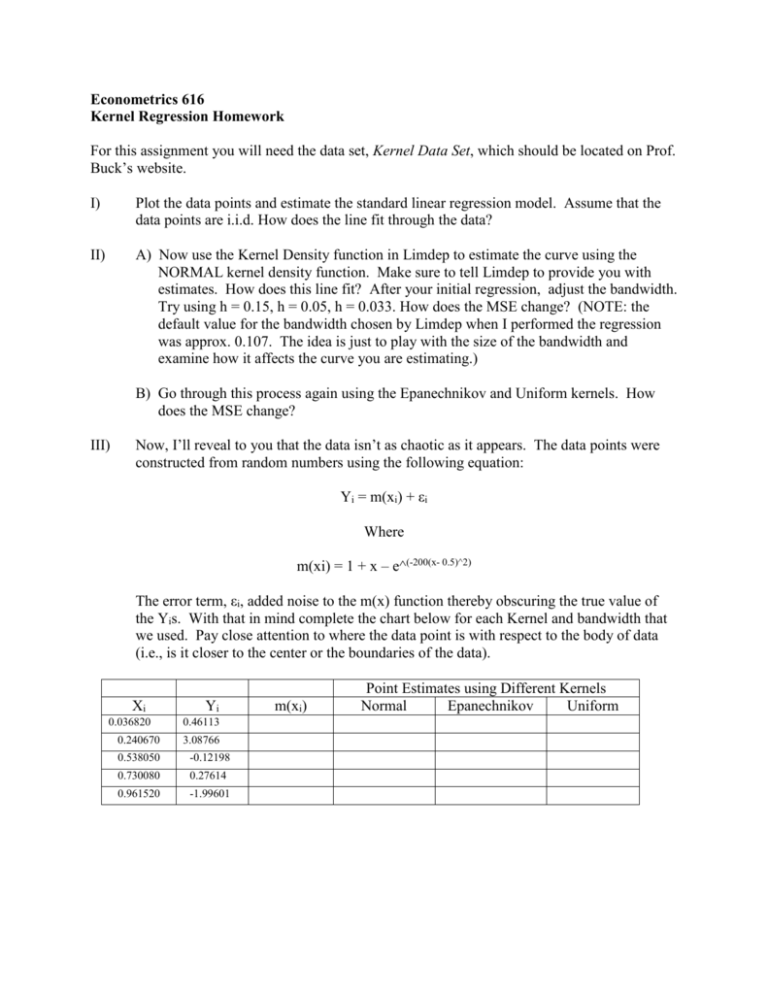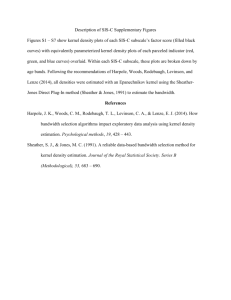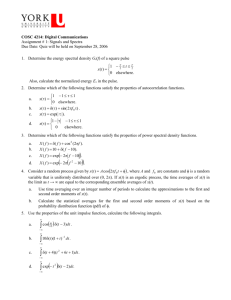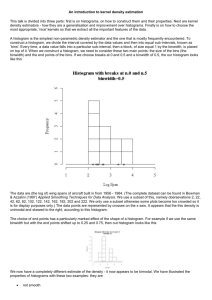Econometrics 616
advertisement

Econometrics 616 Kernel Regression Homework For this assignment you will need the data set, Kernel Data Set, which should be located on Prof. Buck’s website. I) Plot the data points and estimate the standard linear regression model. Assume that the data points are i.i.d. How does the line fit through the data? II) A) Now use the Kernel Density function in Limdep to estimate the curve using the NORMAL kernel density function. Make sure to tell Limdep to provide you with estimates. How does this line fit? After your initial regression, adjust the bandwidth. Try using h = 0.15, h = 0.05, h = 0.033. How does the MSE change? (NOTE: the default value for the bandwidth chosen by Limdep when I performed the regression was approx. 0.107. The idea is just to play with the size of the bandwidth and examine how it affects the curve you are estimating.) B) Go through this process again using the Epanechnikov and Uniform kernels. How does the MSE change? III) Now, I’ll reveal to you that the data isn’t as chaotic as it appears. The data points were constructed from random numbers using the following equation: Yi = m(xi) + εi Where m(xi) = 1 + x – e^(-200(x- 0.5)^2) The error term, εi, added noise to the m(x) function thereby obscuring the true value of the Yis. With that in mind complete the chart below for each Kernel and bandwidth that we used. Pay close attention to where the data point is with respect to the body of data (i.e., is it closer to the center or the boundaries of the data). Xi 0.036820 0.240670 Yi 0.46113 3.08766 0.538050 -0.12198 0.730080 0.27614 0.961520 -1.99601 m(xi) Point Estimates using Different Kernels Normal Epanechnikov Uniform SOLUTIONS I) Regr ession line is Y = 1.23255 - 1.40471X 4 3 2 Y 1 0 -1 -2 -3 -.2 .0 .2 .4 .6 .8 1.0 1.2 X As you can see the data is pretty messy and a linear regression does a poor job of estimating the relationship between X and Y. II) A) Nor mal Ker nel, automatic bandwidth 4 3 E[y | x i ] Y E[y|xi] 2 1 0 -1 -2 -3 -.2 .0 .2 .4 .6 X The curve shows some modest changes. The MSE is 0.991135. .8 1.0 1.2 Nor mal Ker nel, h = 0.15 4 3 E[y | x i ] Y E[y|xi] 2 1 0 -1 -2 -3 -.2 .0 .2 .4 .6 .8 1.0 1.2 X Here, we have an example of oversmoothing. The bandwidth has been set too large and the curve is flatter. We can also see this because the MSE error is larger – our original .991135 vs. the new 1.002058 – showing that our curve loses explanatory power. Nor mal, h = 0.05 4 3 E[y | x i ] Y E[y|xi] 2 1 0 -1 -2 -3 -.2 .0 .2 .4 .6 .8 1.0 1.2 X When we decrease the bandwidth to h = 0.05, our curve takes more shape and does a better job of reflecting changes in the data. Here, the MSE is smaller, .986564. Finally, we examine the h = 0.03. Nor mal, h = 0.033 4 3 E[y | x i ] Y E[y|xi] 2 1 0 -1 -2 -3 -.2 .0 .2 .4 .6 .8 1.0 1.2 X The curve seems more attuned to the peculiarities of the data. However, the MSE is higher, 1.01779. Using some eyeball-ometrics, we can see that the smaller bandwidth has increased the wiggliness of the curve which has not necessarily helped us understand the data better. B) EPANECHNIKOV Epanechnikov, automatic bandwidth 4 3 E[y | x i ] Y E[y|xi] 2 1 0 -1 -2 -3 -.2 .0 .2 .4 .6 .8 1.0 1.2 .8 1.0 1.2 X Epanechnikov, h = 0.15 4 3 E[y | x i ] Y E[y|xi] 2 1 0 -1 -2 -3 -.2 .0 .2 .4 .6 X Epanechnikov, h = 0.05 4 3 E[y | x i ] Y E[y|xi] 2 1 0 -1 -2 -3 -.2 .0 .2 .4 .6 .8 1.0 1.2 X Epanechnikov, h = 0.033 4 3 E[y |x i ] Y E[y|xi] 2 1 0 -1 -2 -3 -.2 .0 .2 .4 .6 X .8 1.0 1.2 Kernel/Bandwidth Epanechnikov/automatic (h = 0.107402) Epanechnikov/h = 0.15 Epanechnikov/h = 0.05 Epanechnikov/h = 0.033 MSE 1.009138 1.008727 0.978633 1.007168 With h = 0.05 bandwidth produces a smooth curve and it had the lowest MSE out of the four bandwidths that we examined. UNIFORM Uniform, automatic bandwidth 4 3 E[y | x i ] Y E[y|xi] 2 1 0 -1 -2 -3 -.2 .0 .2 .4 .6 X .8 1.0 1.2 Unifor m, h = 0.15 4 3 E[y | x i ] Y E[y|xi] 2 1 0 -1 -2 -3 -.2 .0 .2 .4 .6 .8 1.0 1.2 X Uniform, h = 0.05 4 3 E[y |x i ] Y E[y|xi] 2 1 0 -1 -2 -3 -.2 .0 .2 .4 .6 X .8 1.0 1.2 Uniform, h = 0.033 4 3 E[y | x i ] Y E[y|xi] 2 1 0 -1 -2 -3 -.2 .0 .2 .4 .6 .8 1.0 1.2 X Kernel/Bandwidth Normal/automatic (h = 0.107402) Normal/h = 0.15 Normal/h = 0.05 Normal/h = 0.033 MSE 0.976165 0.997415 1.010491 1.076792 Unlike the Epanechnikov kernel, the Uniform kernel had the smallest MSE with the bandwidth chosen for us by Limdep and increased for each value of h that we used. The curve however leaves something to be desired. If we graph the equation, m(xi), we see a straight line with a slope approximately equal to negative one but with large hump in the data between 0.4 and 0.6. 1.6 1.4 1.2 1.0 MX III) .8 .6 .4 .2 .0 -.2 -.2 .0 .2 .4 .6 X .8 1.0 1.2 Point Estimates using Different Kernels Epanechnikov Normal Xi Yi m(xi) h = 0.1074 0.036820 0.240670 0.538050 0.730080 0.961520 0.46113 3.08766 -0.12198 0.27614 -1.99601 0.96318 0.759331 1.21054 0.269945 0.03848 0.776311 0.967842 0.912116 0.070482 -0.238408 Uniform h = 0.15 h = 0.05 h = 0.033 h = 0.1074 h = 0.15 h = 0.05 h = 0.033 h = 0.1074 h = 0.15 h = 0.05 h = 0.033 0.82914 0.94466 0.77368 0.16791 -0.188595 0.625819 1.14414 1.20327 0.015556 -0.318482 0.586258 1.234092 1.287925 0.053820 -0.406496 0.823633 0.918661 0.847258 0.087121 -0.231912 0.862028 0.951045 0.710363 0.216278 -0.185085 0.638951 1.129870 1.178543 -0.008116 -0.290958 0.574723 1.201535 1.25737 0.062559 -0.344837 0.682567 1.041213 1.114961 -0.073108 -0.232247 0.792023 0.925754 0.921829 -0.495533 -0.285052 0.644644 1.222437 1.273009 0.104117 -0.262382 0.524195 1.334865 1.397684 0.143816 -0.531994 We can see that near the boundaries, with the except of the Uniform Kernel, larger bandwidths were better in creating a point estimate which was closer to the true value. In the middle part of the data, a smaller bandwidth was better able to approximate the true value of m(xi), though the Uniform bandwidth again appears to be an exception.







